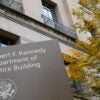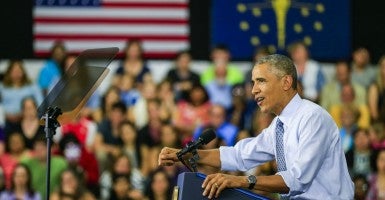On Wednesday, President Barack Obama took an economic victory lap in Elkhart, Indiana. The Bureau of Labor Statistics’ employment report, which came out Friday, shows he was far too optimistic.
Both the household and payroll surveys showed employment growth slowing to a crawl in May, while hundreds of thousands of Americans stopped looking for work. Seven years after the recession officially ended, the economy is not out of the woods.
The Bureau of Labor Statistics has two principal employment surveys: the household survey (which interviews workers) and the payroll survey (which interviews businesses). Both showed tepid job growth in May.
The payroll survey reported employers created just 38,000 net new jobs last month. Almost all this growth occurred in the health care sector (+46,000) and government (+13,000). Most other sectors showed slight gains or experienced job losses. Worryingly, temporary help service employment contracted by 21,000 jobs.
Temporary jobs are often a leading indicator of future hiring patterns: employers typically cut back on temporary employees before letting regular staff go. Additional payroll survey data also showed employers created 59,000 fewer jobs than previously estimated in March and April.
The household survey showed even slower job growth (+26,000), although the difference between the two surveys was not statistically significant. If this hiring rate continues, job creation will not keep pace with population growth and unemployment will rise.
Nonetheless, the household survey reported the unemployment rate fell significantly, from 5 percent to 4.7 percent.
This was not good news; it happened because the number of Americans outside the labor force jumped by 664,000 in May. The government does not count people not looking for work as unemployed. Their exit caused the labor force participation rate to drop 0.2 percentage points, and pushed down the unemployment rate.
But the overall employment-to-population ratio—the proportion of the population with jobs—did not improve at all. The May drop in labor force participation, coming on top of the decrease in April, entirely erased the gains in labor force participation that occurred in the first quarter of 2016.
Economists had expected some of this decline. Demographers long forecast labor force participation would fall as the baby boomers began to retire. But labor force participation fell for younger workers too. The labor force participation rate for so-called prime age workers (25 to 54 years old) also dropped by 0.2 percentage points.
Interestingly, the entire drop in participation for workers 25 and older occurred among Americans without a high school degree. Labor force participation rose slightly for workers with at least a high school education, or more.
More discouraging news came from part-time employment. The number of Americans employed part-time for economic reasons jumped by almost 500,000. In May, many more workers who wanted full-time hours could not find them.
The only bright spot in the report came in wage growth. Average hourly earnings increased 5 cents in May and have risen 2.5 percent over the past year. Since inflation has grown just 1.1 percent over that period, real wages have grown roughly 1.4 percent in the past 12 months. That represents solid growth by historical standards. But it may not last if the labor market weakens.
Obama has overseen the weakest recovery of the post-war era, and this jobs report illustrates just how fragile this recovery has been.






























